
Gavin Lyall "stood in a tradition that went back to Erskine Childers, John Buchan and Dornford Yates," said Peter Gutteridge at the time of the author's death. "He wrote adventures that were both exciting and exceptionally well written."
Like
Duncan Kyle, Gavin Lyall was one of the better adventure writers of the 1960s and 1970s, certainly a more stylish writer than
Alistair MacLean, a fact recognised by the Crime Writer's Association, who awarded him their Silver Dagger for
The Most Dangerous Game and the Gold for
Midnight Plus One.
The son of an accountant, he was born Gavin Tudor Lyall in Birmingham on 9 May 1932. He left King Edward VI School in 1951 and qualified as a pilot officer when he joined the RAF to perform his National Service. He attended Pembroke College, Cambridge, reading English, and briefly worked for the
Birmingham Gazette before landing a job with
Picture Post.
The once famous news magazine was on its last legs by the time Lyall joined and folded a year later, but it was here that Lyall met Katherine Whitehorn, later a long-time columnist with the
Observer, whom he married in 1958. He took a job on the
Sunday Globe but that, too, was shortly to disappear and Lyall became a producer on the
Tonight programme for BBC Television. A year later he joined the
Sunday Times as their air correspondent, a position he remained in until the success of his first novel and the impending publication of a second allowed him to turn freelance.
The Wrong Side of the Sky was a straightforward actioner featuring a cargo pilot hero Jack Clay and several millions in stolen jewels but Lyall's handling of flying scenes and handling of characters set the book apart and it immediately found an American publisher.
The Most Dangerous Game pitted another pilot hero, Bill Cary, against an American hunter in the wastes of Northern Finland, whilst
Midnight Plus One saw morally questionable adventurer Lewis Cane hired to drive a millionaire businessman across Europe to Liechtenstein, the trip enlivened by pursuing crooks and the French police. The film rights to the latter was bought by Steve McQueen, but the film was never made due to McQueen's untimely death.
Lyall continued to turn out engaging thrillers set in exotic locations over the next few years:
Shooting Script featured the pilot of a camera plane and a revolution in the Caribbean;
Venus with Pistol was about art smuggling in London and Vienna;
Blame the Dead saw bodyguard James Card searching for a killer on a trail that leads from Arras to Norway; the
Judas Country of his next novel was the Middle East where pilot Roy Case gets involved in smuggling, espionage and murder.
Seven books in 14 years was not a prolific pace; Lyall put it down to laziness but, according to an anonymous obituarist in the
Daily Telegraph, "it was actually due more to his concern that details in his writing be technically accurate. He liked checking details, since it put off the job of writing. Lyall spent many nights in his kitchen at Primrose Hill, north London, experimenting to see if one could, in fact, cast bullets from lead melted in a saucepan, or whether the muzzle flash of a revolver fired across a saucer of petrol really would ignite a fire. The results of his research bore fruit in a series of pamphlets on the scientific aspects of thrillers that he edited for the Crime Writers' Association in the 1970s." Lyall was chairman of the CWA in 1967-68.
Another persuasion was the deal he had with Booker, the sugar and investments group, who, in 1964, offered him a similar deal to one they had with Ian Fleming towards the end of his life. In return for a lump sum of £25,000 and an annual salary, they and Lyall split the royalties on his books 51-49.
His love of aircraft led him to edit the anthology
The War in the Air 1939-1945: An Anthology of Personal Experiences (1968). He also received a story credit for the SF-thriller
Moon Zero Two (1969).
By the mid-1970s, the action novel was beginning to fall out of favour; Lyall responded by creating Harry Maxim, a former SAS officer operating in the world of Whitehall as a Special Services officer and security advisor to the Prime Minister.
The Secret Servant, in which Maxim debuted, was based on research Lyall had carried out for an abortive Whitehall BBC TV thriller.
The Secret Servant was subsequently filmed by the BBC in 1984 with Charles Dance as Maxim.
With Maxim, Lyall created a character judged by many to be his best creation. "While
The Secret Servant and
The Conduct of Major Maxim lean towards the le Carré school, there is a lighter touch at work," J. Randolph Cox noted. "Suicides and defectors, guilty secrets and the old school tie: these are serious situations with believable and complex characters and a blessed absence of clichés."
Despite their qualities (
The Times believed
The Secret Servant was "the richest of all Lyall's books yet", and all four books were widely praised), the cooling of the Cold War meant that the public were also cooling to modern spy fiction. Lyall changed tack a second time and created Harry Ranklin and Conal O'Gilroy, a disgraced, bankrupt military man and an ex-Fenian both despised by their aristocratic masters, as his protagonists for a new series of historical thriller about the early (pre-WW1) years of the secret service. Four novels, beginning with
Spy's Honour, appeared in the 1990s.
Lyall died in London on 18 January 2003, aged 70, survived by his wife and two sons.
The Times, recalling Lyall's work, said, "Gavin Lyall was one of the most consistent British thriller writers of the past 40 years, bringing to his books a craftsmanship and professionalism that never became formulaic. He was a master of laconic dialogue, of plotting which was satisfyingly complex and rich in double bluffs and of unobtrusively sketched, often exotic, backgrounds. Above all he was a consummate storyteller and compulsively readable."
It's sad to think that only one of Lyall's novels (
Midnight Plus One) is currently in print.
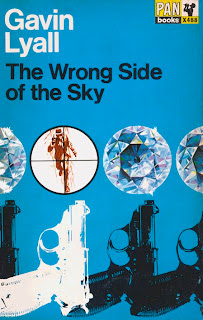

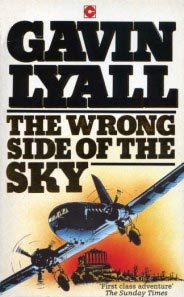.jpg) The Wrong Side of the Sky (London, Hodder & Stoughton, 1961; New York, Scribner, 1961)
Pan X488, Mar 1966. Cover by Raymond Hawkey
Pan 0330-10488-8, 1971. Cover by Chris Foss
---- [9th imp.] 1979, 236pp, 80p. Cover by Chris Foss
Pan 0330-10488-8 [10th imp.], 1983. Cover: photo (Colin Thomas)
Coronet 0340-54416-3, Feb 1991.
The Wrong Side of the Sky (London, Hodder & Stoughton, 1961; New York, Scribner, 1961)
Pan X488, Mar 1966. Cover by Raymond Hawkey
Pan 0330-10488-8, 1971. Cover by Chris Foss
---- [9th imp.] 1979, 236pp, 80p. Cover by Chris Foss
Pan 0330-10488-8 [10th imp.], 1983. Cover: photo (Colin Thomas)
Coronet 0340-54416-3, Feb 1991.

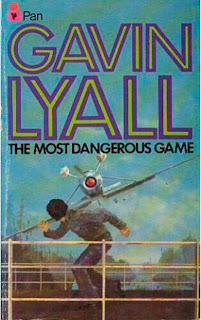.jpg)
.jpg) The Most Dangerous Game (New York, Scribner, 1963; London, Hodder & Stoughton, 1964)
The Most Dangerous Game (New York, Scribner, 1963; London, Hodder & Stoughton, 1964)
Pan X487, 1966. Cover by Raymond Hawkey
Pan 0330-10487-X, Oct 1971.
Pan 0330-10487-X, c.1973. Cover by Chris Foss
Pan 0330-10487-X [13th imp.] 1983, 222pp, £1.50. Cover photo by Colin Thomas
Coronet 0340-53023-5, Aug 1990.
Midnight Plus One (London, Hodder & Stoughton, 1965; New York, Scribner, 1965)
Pan X530, 1966; 1967; 1969. Cover by Raymond Hawkey
Pan 0330-10530-2, 1973. Cover by Harry Hants
Pan 0330-10530-2, [11th imp.] 1983. Cover photo by (Colin Thomas?)
Coronet 0340-53024-3, 1990.
Orion Crime Masterworks 0-75286717-2, 2005.

.jpg)
.jpg) Shooting Script (London, Hodder & Stoughton, 1966; New York, Scribner, 1966)
Shooting Script (London, Hodder & Stoughton, 1966; New York, Scribner, 1966)
Pan M231, 1967. Cover by Raymond Hawkey
Pan 0330-17304-1, Aug 1973. Cover by Chris Foss
Pan 0330-02059-5, 1979.
---- [8th imp.] 1983, 234pp, £1.75. Cover photo by Colin Thomas
Pan, 1986?
Coronet 0-34042975-5, 1989.
 Venus With Pistol (London, Hodder & Stoughton, 1969; New York, Scribner, 1969)
Pan, 0330-02759-X, Oct 1971. Cover by Raymond Hawkey
---- [xth imp.], 1973. Cover by Chris Foss
---- [xth imp.], (1986?), 237pp, £2.50. Cover photo by Derek Askem
Coronet 0-34051580-5, Feb 1990.
Venus With Pistol (London, Hodder & Stoughton, 1969; New York, Scribner, 1969)
Pan, 0330-02759-X, Oct 1971. Cover by Raymond Hawkey
---- [xth imp.], 1973. Cover by Chris Foss
---- [xth imp.], (1986?), 237pp, £2.50. Cover photo by Derek Askem
Coronet 0-34051580-5, Feb 1990.

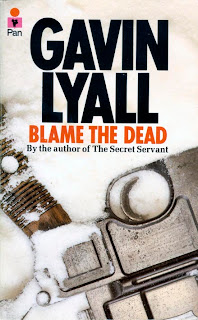.jpg)
Blame the Dead (London, Hodder & Stoughton, 1972; New York, Viking, 1973)
Pan 0330-24115-X, Oct 1974. Cover by Harry Hants?
Pan 0330-24115-X, [6th imp.] 1982. Cover: photo by Colin Thomas
Pan 0330-24115-X [8th imp.] nd (1986?), 285pp, £2.50. Cover: photo by Colin Thomas
Coronet 0340-42976-3, Aug 1989.
.jpg)
.jpg)
.jpg)
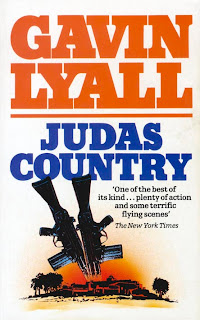 Judas Country (London, Hodder & Stoughton, 1975; New York, Viking, 1975)
Judas Country (London, Hodder & Stoughton, 1975; New York, Viking, 1975)
Pan 0330-24722-0, Jul 1976. Cover by Harry Hants
Pan 0330-24722-0, [3rd imp.] 1982. Cover: photo (Colin Thomas)
Pan, 1986?
Coronet 0340-51581-3, Feb 1990.
The Secret Servant (London, Hodder & Stoughton, 1980; New York, Viking, 1980)
Pan 0330-26456-7, (Oct) 1982, 220pp. Cover: photo (Colin Thomas)
---- [6th imp.] n.d., £1.75.
Coronet 0340-54417-1, 1991.

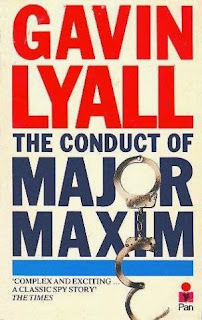.jpg) The Conduct of Major Maxim (London, Hodder & Stoughton, 1982; New York, Viking, 1983)
Pan 0330-28116-X, Nov 1983.
---- [2nd imp.] 1983
---- [3rd imp.] n.d.
Pan [xth imp.] (1986?)
Coronet 0340-58865-9, 1993.
The Conduct of Major Maxim (London, Hodder & Stoughton, 1982; New York, Viking, 1983)
Pan 0330-28116-X, Nov 1983.
---- [2nd imp.] 1983
---- [3rd imp.] n.d.
Pan [xth imp.] (1986?)
Coronet 0340-58865-9, 1993.
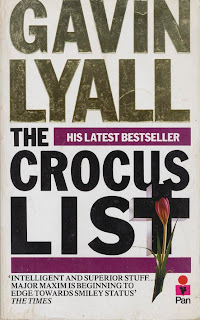 The Crocus List (London, Hodder & Stoughton, 1985; New York, Viking, 1986)
Pan 0330-29195-5, May 1986.
Coronet 0340-59797-6, Aug 1993.
The Crocus List (London, Hodder & Stoughton, 1985; New York, Viking, 1986)
Pan 0330-29195-5, May 1986.
Coronet 0340-59797-6, Aug 1993.
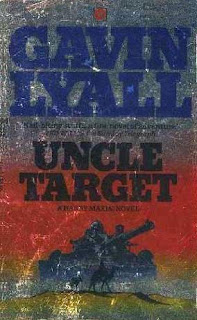 Uncle Target (London, Hodder & Stoughton, 1988; New York, Viking, 1988)
Coronet 0340-48841-7, 1989, 300pp, £2.99.
---- [2nd imp.] 1989.
Uncle Target (London, Hodder & Stoughton, 1988; New York, Viking, 1988)
Coronet 0340-48841-7, 1989, 300pp, £2.99.
---- [2nd imp.] 1989.
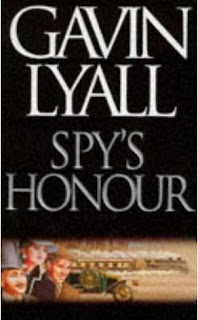 Spy’s Honour (London, Hodder & Stoughton, 1993; New York, St. Martin’s, 1995)
Coronet 0340-60972-9, Oct 1994.
Spy’s Honour (London, Hodder & Stoughton, 1993; New York, St. Martin’s, 1995)
Coronet 0340-60972-9, Oct 1994.
 Flight From Honour (London, Hodder & Stoughton, 1996)
Coronet 0340-68190-X, Apr 1997.
Flight From Honour (London, Hodder & Stoughton, 1996)
Coronet 0340-68190-X, Apr 1997.
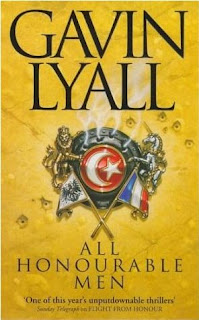 All Honourable Men (London, Hodder & Stoughton, 1997)
Coronet 0340-70855-7, Aug 1998, 298pp, £5.99. Cover by David Scott
---- [2nd imp.] n.d.
All Honourable Men (London, Hodder & Stoughton, 1997)
Coronet 0340-70855-7, Aug 1998, 298pp, £5.99. Cover by David Scott
---- [2nd imp.] n.d.
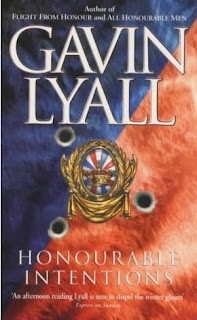 Honourable Intentions (London, Hodder & Stoughton, 1999)
Coronet 0340-75077-4, (Mar) 2000, 247pp, £5.99. Cover by David Scutt
Honourable Intentions (London, Hodder & Stoughton, 1999)
Coronet 0340-75077-4, (Mar) 2000, 247pp, £5.99. Cover by David Scutt
NON-FICTION
 The Pictorial Story of the Royal Tour of India and Pakistan and the State Visits to Nepal and Iran (London, Pitkin, 1961)
The Pictorial Story of the Royal Tour of India and Pakistan and the State Visits to Nepal and Iran (London, Pitkin, 1961)
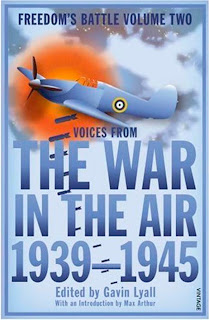 The War in the Air 1939-1945: An Anthology of Personal Experience Volume 2: Freedom’s Battle (London, Hutchinson, 1968; as The War In the Air: The Royal Air Force in World War II, New York, Morrow, 1969)
Arrow Books 0-09004470-3, 1971.
Pimlico 0-71266069-0, Sep 1994.
Pimlico 1-84595074-7, Jul 2007.
Vintage 1-84595084-4, Sep 2007.
The War in the Air 1939-1945: An Anthology of Personal Experience Volume 2: Freedom’s Battle (London, Hutchinson, 1968; as The War In the Air: The Royal Air Force in World War II, New York, Morrow, 1969)
Arrow Books 0-09004470-3, 1971.
Pimlico 0-71266069-0, Sep 1994.
Pimlico 1-84595074-7, Jul 2007.
Vintage 1-84595084-4, Sep 2007.
 Operation Warboard. Wargaming World War II battles in 20-25mm scale, with Bernard Lyall (London, A. & C. Black, 1976)
Pan 0330-25547-9, Nov 1978.
Operation Warboard. Wargaming World War II battles in 20-25mm scale, with Bernard Lyall (London, A. & C. Black, 1976)
Pan 0330-25547-9, Nov 1978.
 On Monday, various sites noted the death last week of Carlos Gabriel Roume, a leading Argentinean comic artist, painter and sculptor. He died on 26 September 2009 in Tandil in the Buenos Aires Province, aged 86.
On Monday, various sites noted the death last week of Carlos Gabriel Roume, a leading Argentinean comic artist, painter and sculptor. He died on 26 September 2009 in Tandil in the Buenos Aires Province, aged 86.
 In 1959, Roume joined other South American artists working for the British market, drawing episodes of "Dick Daring" for Thriller Picture Library and "Buck Jones", "Kansas Kid", "The Gun Tamers" and "Kit Carson" for Cowboy Picture Library. He made the step to weekly comics taking over "Olac the Gladiator" from Ruggero Giovannini in Tiger in 1961-62; other weekly strips followed, including "Blade of the Frontier" (Valiant, 1962-63), "Two Fists Against the World" (Hurricane, 1964), "Rodney Stone" (Ranger / Look & Learn, 1966) and "Black Beauty" (Tina, 1967).
In 1959, Roume joined other South American artists working for the British market, drawing episodes of "Dick Daring" for Thriller Picture Library and "Buck Jones", "Kansas Kid", "The Gun Tamers" and "Kit Carson" for Cowboy Picture Library. He made the step to weekly comics taking over "Olac the Gladiator" from Ruggero Giovannini in Tiger in 1961-62; other weekly strips followed, including "Blade of the Frontier" (Valiant, 1962-63), "Two Fists Against the World" (Hurricane, 1964), "Rodney Stone" (Ranger / Look & Learn, 1966) and "Black Beauty" (Tina, 1967). (* photo found here; "Rodney Stone", adapting the novel by Sir Arthur Conan Doyle, and illustration "Horses on the Camargue" both © Look and Learn Ltd.)
(* photo found here; "Rodney Stone", adapting the novel by Sir Arthur Conan Doyle, and illustration "Horses on the Camargue" both © Look and Learn Ltd.)
















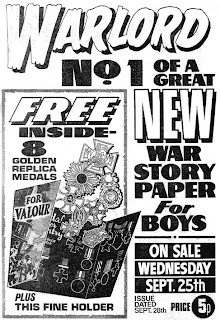



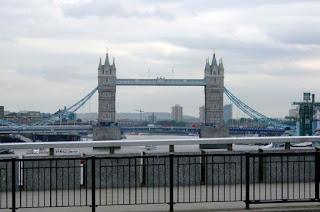
















.jpg)

.jpg)


.jpg)
.jpg)

.jpg)
.jpg)
.jpg)

.jpg)

.jpg)




.jpg)

.jpg)
.jpg)
.jpg)



.jpg)









































